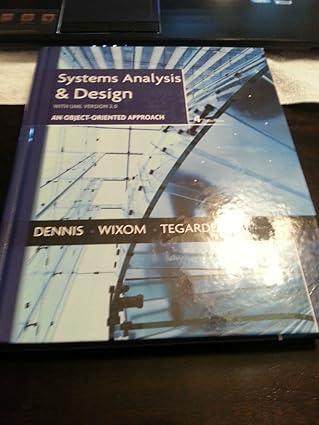For the Picnics R Us problem in Chapters 4 (exercises R, S, and T) and 5 (exercises
Question:
For the Picnics R Us problem in Chapters 4 (exercises R, S, and T) and 5 (exercises V and W):
1. Choose one use case and, for each scenario, create a sequence diagram.
2. Create a communication diagram for each scenario of the use case chosen in Question 1.
3. Create a behavioral state machine to depict one of the classes on the class diagram you created for Chapter 5, exercise V.
4. Perform a CRUDE analysis to show the interactivity of the objects in the system.
5. Perform a verification and validation walkthrough of the problem.
Exercises R, S, and T In Chapter 4
R. Draw a use-case diagram and a set of activity diagrams for the following system. Picnics R Us (PRU) is a small catering firm with five employees. During a typical summer weekend, PRU caters fifteen picnics with twenty to fifty people each. The business has grown rapidly over the past year and the owner wants to install a new computer system for managing the ordering and buying process. PRU has a set of ten standard menus. When potential customers call, the receptionist describes the menus to them. If the customer decides to book a picnic, the receptionist records the customer information (e.g., name, address, phone number) and the information about the picnic (e.g., place, date, time, which one of the standard menus, total price) on a contract. The customer is then faxed a copy of the contract and must sign and return it along with a deposit (often a credit card or by debit card) before the picnic is officially booked. The remaining money is collected when the picnic is delivered.
Sometimes, the customer wants something special (e.g., birthday cake). In this case, the receptionist takes the information and gives it to the owner, who determines the cost; the receptionist then calls the customer back with the price information. Sometimes the customer accepts the price, other times, the customer requests some changes that have to go back to the owner for a new cost estimate. Each week, the owner looks through the picnics scheduled for that weekend and orders the supplies (e.g., plates) and food (e.g., bread, chicken) needed to make them. The owner would like to use the system for marketing as well. It should be able to track how customers learned about PRU and identify repeat customers, so that PRU can mail special offers to them. The owner also wants to track the picnics for which PRU sent a contract, but the customer never signed the contract and actually booked a picnic.
S. Create a set of detailed use-case descriptions for the system in exercise R.
T. Perform a verification and validation walkthrough of the functional models of the catering system described in exercises R and S.
Exercise V and W In Chapter 5
V. Using the seven-step process described in this chapter, create a structural model for exercise R in Chapter 4.
W. Perform a verification and validation walkthrough for the structural model created for exercise V.
Step by Step Answer:

Systems Analysis And Design With UML 2.0
ISBN: 9781118037423
4th Edition
Authors: Alan Dennis, Barbara Haley Wixom, David Tegarden




